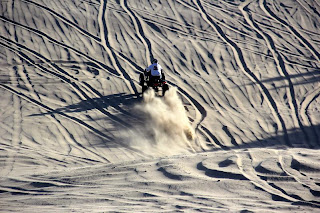The deep hole left by the eruptions filled with water from precipitation over several hundred years. There are no streams or rivers flowing into the lake. The water level in the lake is determined only by lake water evaporation and precipitation from rain and snow, so water level fluctuates from year to year depending on the weather patterns. The lake gets an average of over 500 inches of snow each winter, making Crater Lake one of the snowiest areas in the Northwest US . The lake has an average water depth of about 1150 ft, with a maximum measured depth of 1949 feet, making it the deepest lake in the United States
Because there are no inflowing tributaries, and there has been no recent strong hydrothermal or volcanic activity, the clarity of the water is excellent, with the ability to see light colored objects 100-115 ft deep in the water.
There are no indigenous fish in the lake, but the lake was stocked with a large variety of fish species from the late 1800s to mid 1900s. Although the water is alkaline and lacks significant mineral content, several of these species have formed populations that have thus far been able to sustain themselves, primarily landlocked salmon and rainbow trout.
Sorry, no fish pictures….
The caldera rim ranges between about 6500 to about 8000 ft above sea level.
There has been some volcanic activity since the initial caldera creation, and this more recent activity has created a large island in the lake called Wizard Island
One of the mountains original cones – Phantom Cone – has left another island in the lake, named Phantom Ship. Although it looks quite small in the picture, it is as high as a 14 story building, reaching 160 Feet above lake level.
I found a snow bunny playing in this considerable snow bank, still here on August 30th, just a few days before Labor Day.
She turned out to be hostile, throwing snowballs at me, so I moved on around the lake loop road.
On the eastern wall of the crater there is a rusty looking spot, different from the rest of the terrain.
Using a telephoto lens to get a larger image, you see what is shown below.
This formation is called the Pumice Castle
We noticed a tree with lots of birds sitting on the branches.
Closer examination revealed not birds, but pinecones.
We originally debated whether to drive the Motorcoach with Toad in tow around the 33 mile loop road around Crater Lake rim. After discussions with other RVers we decided not to drive the coach, but to take the S2000, and after driving it and seeing roads like the one shown below, I’m glad we took the sports car.
I’m afraid if you were inattentive for a second and got the front wheel of a Motorcoach over the edge of this part of the road, and you might not fare too well. There were several drop-offs like this and not a guardrail in sight.
Well, that’s life in the fast lane, even though the speed limit was 35 MPH throughout most of the park.



















































